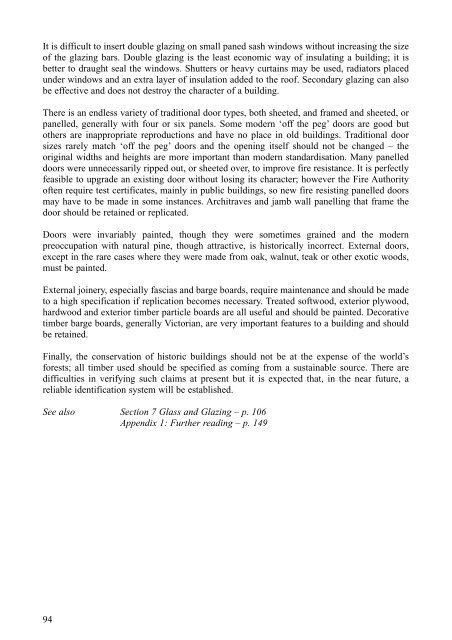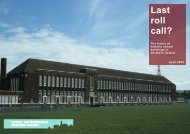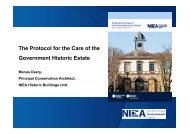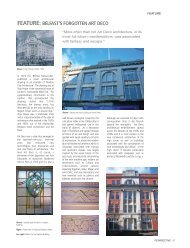Directory of Traditional Building Skills - Mourne Heritage Trust
Directory of Traditional Building Skills - Mourne Heritage Trust
Directory of Traditional Building Skills - Mourne Heritage Trust
Create successful ePaper yourself
Turn your PDF publications into a flip-book with our unique Google optimized e-Paper software.
It is difficult to insert double glazing on small paned sash windows without increasing the size<strong>of</strong> the glazing bars. Double glazing is the least economic way <strong>of</strong> insulating a building; it isbetter to draught seal the windows. Shutters or heavy curtains may be used, radiators placedunder windows and an extra layer <strong>of</strong> insulation added to the ro<strong>of</strong>. Secondary glazing can alsobe effective and does not destroy the character <strong>of</strong> a building.There is an endless variety <strong>of</strong> traditional door types, both sheeted, and framed and sheeted, orpanelled, generally with four or six panels. Some modern ‘<strong>of</strong>f the peg’ doors are good butothers are inappropriate reproductions and have no place in old buildings. <strong>Traditional</strong> doorsizes rarely match ‘<strong>of</strong>f the peg’ doors and the opening itself should not be changed – theoriginal widths and heights are more important than modern standardisation. Many panelleddoors were unnecessarily ripped out, or sheeted over, to improve fire resistance. It is perfectlyfeasible to upgrade an existing door without losing its character; however the Fire Authority<strong>of</strong>ten require test certificates, mainly in public buildings, so new fire resisting panelled doorsmay have to be made in some instances. Architraves and jamb wall panelling that frame thedoor should be retained or replicated.Doors were invariably painted, though they were sometimes grained and the modernpreoccupation with natural pine, though attractive, is historically incorrect. External doors,except in the rare cases where they were made from oak, walnut, teak or other exotic woods,must be painted.External joinery, especially fascias and barge boards, require maintenance and should be madeto a high specification if replication becomes necessary. Treated s<strong>of</strong>twood, exterior plywood,hardwood and exterior timber particle boards are all useful and should be painted. Decorativetimber barge boards, generally Victorian, are very important features to a building and shouldbe retained.Finally, the conservation <strong>of</strong> historic buildings should not be at the expense <strong>of</strong> the world’sforests; all timber used should be specified as coming from a sustainable source. There aredifficulties in verifying such claims at present but it is expected that, in the near future, areliable identification system will be established.See also Section 7 Glass and Glazing – p. 106Appendix 1: Further reading – p. 14994











